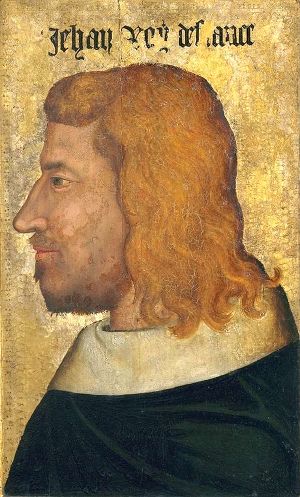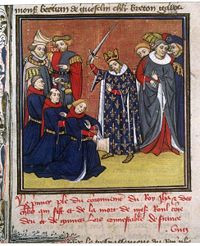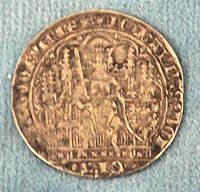John II of France

John II (April 16, 1319 – April 8, 1364), called John the Good, was Count of Anjou, Count of Maine, and Duke of Normandy from 1332, Count of Poitiers from 1344, Duke of Aquitaine from 1345, and King of France from 1350 until his death, as well as Duke of Burgundy (as John I) from 1361 to 1363. By his marriage to Joanna I, Countess of Auvergne and Boulogne, he became jure uxoris Count of Auvergne and Boulogne from 1349 to 1360. John was a member of the House of Valois, and was the son of Philippe VI and Jeanne of Burgundy. John succeeded his father in 1350 and was crowned at Notre-Dame de Reims. As king, John Later in his reign, he took over more of the administration himself. In the Hundred Years' War begun by Edward III of England to assert his claim on the French throne, John suffered a humiliating defeat at the Battle of Poitiers in 1356.
He was captured and taken to England, where he died while negotiating a treaty with Edward. John's France was rife with division between classes and regions, exasperated by the expense of war and damage to property caused by war. John tried to balance factions but without any marked success. His tendency to trust government officials with responsibility, who were usually of modest social origins, annoyed both the nobility and the Bourgeoisie alike. Controlling the Estates General (parliament), these factions taxed the peasants heavily to fund repairs to war-damaged property but did not compensate the peasants for working on their own properties. While in England, Parliament was beginning to constrain kingly rule and to share power across all classes, the French Estates General functioned mainly to rubber stamp the king's proposals. What did not develop in France at this time was the concept of the nation as a common-wealth, in which everyone considers the welfare of the whole. In England, the realm was already being spoken of as the "community of England" (communitas). Only such a foundation can eventually result in a world where all people live wholesome, dignified lives in freedom, with dignity, honor and the ability to achieve their highest potential.
Early life
John’s father Philip VI took the throne of France in 1328, when John was still 9 years old. His succession had rested on a deliberate political choice resulting from the deaths of Louis X in 1316 and Charles IV in 1328 – preventing the crown from passing to women, and thus to Edward III of England, son of Isabelle of France and grandson of Philip the Fair. Edward, however, claimed the throne and launched the Hundred Years' War. The new king was therefore determined to assert the legitimacy of his dynasty. In 1332, the birth of Charles II of Navarre presented what was claimed to be a better claim to the crown of France than that of Edward. Charles II of Navarre was son of Joan II of Navarre and grandson of Louis X. Philip decided to marry off his son—then thirteen years old—quickly to form a strong matrimonial alliance, at the same time conferring upon him the title of Duke of Normandy.
Thought was initially given to a marriage with Eleanor, sister of the King of England, but instead Philip invited John of Luxembourg, King of Bohemia, to Fontainebleau to propose an alliance which would be cemented by the marriage of one of John’s daughters with Philip’s son. Bohemia, which had aspirations towards Lombardy and needed French diplomatic support, accepted the deal. The military clauses of the treaty stipulated that in the event of war Bohemia would support the French army with four hundred infantrymen. The political clauses ensured that the Lombard crown would not be disputed if the King of Bohemia managed to obtain it. Philip selected Bonne of Bohemia as a wife for his son because she was closer to child-bearing age (16 years), and the dowry was fixed at 120,000 florins.
Marriage with Bonne of Bohemia
John came of age on April 26, 1332, and received overlordship of the duchy of Normandy, as well as the counties of Anjou and Maine. The wedding was celebrated on July 28, at the church of Notre-Dame in Melun in the presence of six thousand guests. The festivities were prolonged by a further two months when the young groom was finally knighted at the cathedral of Notre-Dame in Paris. Duke John of Normandy was solemnly granted the arms of a knight in front of a prestigious assistance bringing together the kings of Luxembourg and Navarre, and the dukes of Burgundy, Lorraine and the Brabant.
Duke of Normandy
In 1332, John became Duke of Normandy in prerogative, and had to deal with the reality that most of the Norman nobility was already allied with the English camp. Effectively, Normandy depended economically more on maritime trade across the English Channel than it did by river trade on the Seine. The duchy had not been English for 150 years but many landowners had possessions across the Channel. Consequently, to line up behind one or other sovereign risked confiscation. Therefore the Norman nobility were governed as interdependent clans which allowed them to obtain and maintain charters guaranteeing the duchy a deal of autonomy. It was split into two key camps, the counts of Tancarville and the counts of Harcourt—which had been at conflict for generations.
Tension arose again in 1341. The king, worried about the richest area of the kingdom breaking into bloodshed, ordered the bailiffs of Bayeux and Cotentin to quell the dispute. Geoffroy d' Harcourt raised troops against the king, rallying a number of nobles protective of their autonomy and against royal interference. The rebels demanded that Geoffroy be made duke, thus guaranteeing the autonomy granted by the charter. Royal troops took the castle at Saint-Sauveur-le-Vicomte and Geoffroy was exiled to the Brabant. Three of his companions were decapitated in Paris on April 3, 1344.
By 1345, increasing numbers of Norman rebels had begun to pay homage to Edward III, constituting a major threat to the legitimacy of the Valois kings. The defeat at Crécy and the rendering of Calais further damaged royal prestige. Defections by the nobility increased—particularly in the north and west whose land fell within the broad economic influence of England. Consequently the French king decided to seek a truce. Duke John met Geoffroy d' Harcourt, to whom the king agreed to return all confiscated goods; even appointing him sovereign captain in Normandy. John then approached the Tancarville which represented the key clan whose loyalty could ultimately ensure his authority in Normandy. The marriage of John, Viscount of Melun to Jeanne, the only heiress of the county of Tancarville ensured the Melun-Tancarville party remained loyal to John the Good, while Godefroy de Harcourt continued to act as defender for Norman freedoms and thus of the reforming party.[1]
Treaty of Mantes
In 1354, John's son-in-law and cousin, Charles II of Navarre, who, in addition to his small Pyrenean kingdom, also held extensive lands in Normandy, was implicated in the assassination of the Constable of France, Charles de la Cerda. Nevertheless, in order to have a strategic ally against the English in Gascony, on February 22, 1354, John signed the Treaty of Mantes with Charles. The peace did not last between the two and Charles eventually struck up an alliance with Henry of Grosmont, the first Duke of Lancaster. The next year (1355), John signed the Treaty of Valognes with Charles, but this second peace lasted hardly longer than the first. In 1355, the Hundred Years' War flared up again.
In the Battle of Poitiers (1356) against Edward, the Black Prince, (son of King Edward III of England), John suffered a humiliating defeat and was taken as captive back to England. While negotiating a peace accord, he was at first held in the Savoy Palace, then at a variety of locations, including Windsor, Hertford, Somerton Castle in Lincolnshire, Berkhamsted Castle in Hertfordshire and briefly at King John's Lodge, formerly known as Shortridges, in East Sussex. A local tradition in St Albans is that he was held in a house in that town, at the site of the fifteenth century Fleur de Lys inn, before he was moved to Hertford. There is a sign on the inn to that effect, but apparently no evidence to confirm the tradition.[2] Eventually, John was taken to the Tower of London.
Prisoner of the English
As a prisoner of the English, John was granted royal privileges, permitting him to travel about and to enjoy a regal lifestyle. At a time when law and order was breaking down in France and the government was having a hard time raising money for the defense of the realm, his account books during his captivity show that he was purchasing horses, pets, and clothes while maintaining an astrologer and a court band.
The Treaty of Brétigny (1360) set his ransom at 3,000,000 crowns. Leaving his son Louis of Anjou in English-held Calais as a replacement hostage, John was allowed to return to France to raise the funds.
While King John tried to raise the money, his son Louis, accorded the same royal dignity, easily escaped from the English. However, John had agreed liberal concessions to Edward's territorial claims in France, although Edward was also to relinquish his claim to the throne.[3] In October, 1363, the Estates General refused to ratify the treaty. An angry King John then surrendered himself again to the English, claiming an inability to pay the ransom as the reason. When John arrived in England in early 1364, however, he was viewed with admiration by ordinary citizens and English royalty alike. Although treated with honor while held in the Savoy Palace, he died in London a few months later, just as he was "about to negotiate a new treaty."[4]
His body was returned to France, where he was interred in the royal chambers at Saint Denis Basilica.
Personality
John suffered from fragile health. He engaged little in physical activity, practiced jousting rarely, and only occasionally hunted. Contemporaries report that he was quick to get angry and resort to violence, leading to frequent political and diplomatic confrontations. He enjoyed literature, and was patron to painters and musicians. His mother, who had frequently acted as regent while his father was fighting the war against England, had patronized learning especially translations from Latin into French.
He took a wife Bonne of Bohemia, and fathered 10 children, in eleven years. Some historians[5] also suggest a strong romantic attachment to Charles de la Cerda. La Cerda was given various honors and appointed to the high position of connetable when John became king; he accompanied the king on all his official journeys to the provinces. La Cerda's rise at court excited the jealousy of the French barons, several of whom stabbed him to death in 1354. As such, La Cerda's fate paralleled that of Edward II's Piers Gaveston, Ist Earl of Cornwall in England, and John II of Castile's Alvaro de Luna in Spain; the position of a royal favorite was a dangerous one. John's grief on La Cerda's death was overt and public.
Legacy
Despite his ill-health and disinterest in jousting, John has been depicted as image of a "warrior king." This probably emerged from the courage in battle he showed at Poitiers, and the creation of the Order of the Star. This was guided by political need as John was determined to prove the legitimacy of his crown—particularly as his reign, like that of his father, was marked by continuing disputes over the Valois claim from both Charles of Navarre and Edward III. From a young age, John was called to resist the de-centralizing forces which impacted upon the cities and the nobility; each attracted either by English economic influence or the reforming parties. These either wanted greater participation in governance by the elite or by the middle classes. John tended to delegate power to heads of departments, who were usually "men of modest social origins."[6] His mother had privileged people from Burgundy at court at the expense of the pro-English North West, which created resentment. John tried to balance factions by appointing members to the royal council. This membership, however, changed rapidly while department heads continued in office for long periods; Parisians bourgeoisie, supporters of Navarre, especially "harbored grudges against these royal officials." Increasingly, since both the bourgeoisie and the equally the estranged nobility controlled the Estates General (parliament), this body refused to fund John's war.[6] On the other hand, the nobles used the Estates General—in the King's absence—to tax the peasants heavily to pay for war-damage to their property while the peasants had to repair theirs without compensation. In 1358, this led to the revolt known as the "Jacquerie." Navarre crushed this revolt mercilessly, mowing the peasants "down in heaps and slaughtering them like cattle."[7] In addition to the financial hardship caused by the war, France was also still recovering from the Black Death of 1348), which had killed a third of the population, including John's mother.
Meanwhile, in Edward III's England, the House of Commons representing the knights and burghers from the towns and shires was flexing its muscles alongside the House of Lords where the nobility sat. Taxes now had to be agreed by both Houses, and the king had to demonstrate not only that they were needed but that they would benefit the whole realm. In England, different interest groups were cooperating to forge a shared system of governance in which all classes were represented. In France, competition and jealousy was rampant between different classes as well as different regions. As an island nation, England was arguably more cohesive geographically. It was only a short while ago that "France" had consisted of little other than greater Paris. Not until after the French Revolution would the non-elite in France gain a similar share in governance. The French Estates General, in contrast to the evolving English parliament, was an organ of "propaganda for royal policy" which "did not fix grants of taxation." It played no essential role in "furthering royal policy."[8] The English parliament already had "true power" and could constrain the king's authority.[9]
Ancestry
Family and children
On July 28, 1332, at the age of 13, John was married to Bonne of Bohemia (d. 1349), daughter of John I (the Blind) of Bohemia. Their children were:
- Charles V (January 21, 1338–September 16, 1380)
- Louis I, Duke of Anjou (July 23, 1339–September 20, 1384)
- John, Duke of Berry (November 30, 1340–June 15, 1416)
- Philippe II, Duke of Burgundy (January 17, 1342–April 27, 1404)
- Jeanne (June 24, 1343–November 3, 1373), married Charles II (the Bad) of Navarre
- Marie (September 12, 1344–October 1404), married Robert I, Duke of Bar
- Agnès (1345–1349)
- Marguerite (1347–1352)
- Isabelle of Valois (October 1, 1348–September 11, 1372), married Gian Galeazzo I, Duke of Milan
On February 19, 1349 (old style), at Nanterre, he married Joanna I of Auvergne (d. 1361), Countess of Auvergne and Boulogne. She was widow of Philip of Burgundy, the deceased heir of that duchy, and mother of the young Philip I, Duke of Burgundy (1344-61) who became John's stepson and ward. John and Joanna had two daughters, both of whom died young:
- Blanche (b. 1350)
- Catherine (b. 1352)
He was succeeded by his son, Charles V of France.
Notes
ReferencesISBN links support NWE through referral fees
- Autrand, Françoise. 1994. Charles V: le Sage. Paris, FR: Fayard. ISBN 9782213027692.
- Deviosse, Jean. 1985. Jean le Bon. Paris, FR: Fayard. ISBN 9782213015583.
- Keen, Maurice. 1969. The Pelican History of Medieval Europe. Baltimore, MD: Penguin Books.
- Knecht, R.J. 2004. The Valois: Kings of France, 1328-1589. London, UK: Hambledon and London. ISBN 9781852854201.
- Kibler, William W. 1995. Medieval France: An Encyclopedia. New York, NY: Garland Pub. ISBN 9780824044442.
Credits
New World Encyclopedia writers and editors rewrote and completed the Wikipedia article in accordance with New World Encyclopedia standards. This article abides by terms of the Creative Commons CC-by-sa 3.0 License (CC-by-sa), which may be used and disseminated with proper attribution. Credit is due under the terms of this license that can reference both the New World Encyclopedia contributors and the selfless volunteer contributors of the Wikimedia Foundation. To cite this article click here for a list of acceptable citing formats.The history of earlier contributions by wikipedians is accessible to researchers here:
The history of this article since it was imported to New World Encyclopedia:
Note: Some restrictions may apply to use of individual images which are separately licensed.

